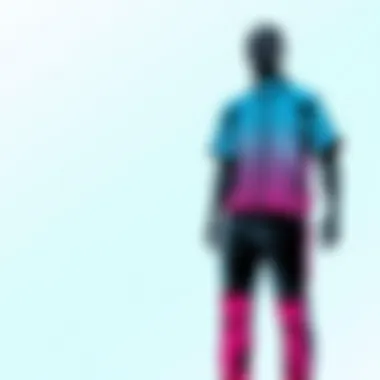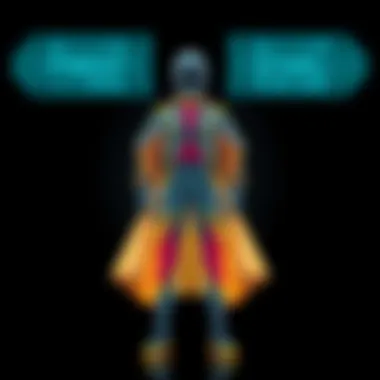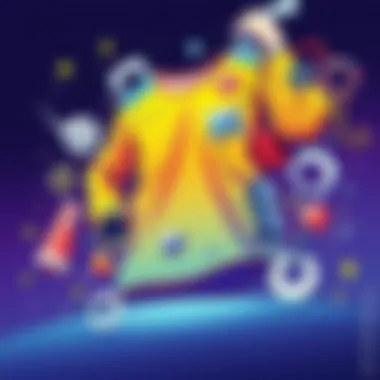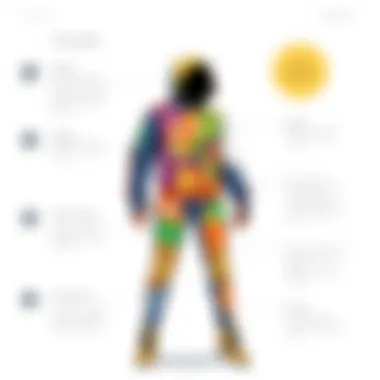Printable Clothes: Transforming Fashion for Future Generations


Intro
As we navigate through the rapidly evolving landscape of fashion, the concept of printable clothes emerges as a significant player in this narrative. The notion is not merely an abstract idea; it marries creativity with technology, allowing for the design and creation of garments in ways previously unimaginable. For many, the mere thought of utilizing a printer to conjure up clothing may sound like something out of science fiction, yet this is quickly becoming a reality. Whether it's a t-shirt adorned with custom designs or an innovative outfit that changes color at the press of a button, printable clothes offer a fresh perspective on personal expression through fashion.
The implications of this advancement extend beyond individual creativity. Sustainability is one of the biggest buzzwords in today's fashion discourse. By minimizing waste and optimizing resource usage, printable clothing can help address the environmental challenges often associated with traditional garment production. This aspect is crucial in educating both children and adults about the importance of eco-friendly practices in all walks of life.
Furthermore, as we delve deeper into printable clothing, we will explore its role in imparting knowledge and encouraging creativity among younger generations. From classrooms equipped with 3D printers to DIY workshops that spark imagination, the educational potential surrounding printable garments is vast. In this article, we will dissect the intertwined concepts of technology, sustainability, and creativity in fashion education, targeting parents, educators, and industry enthusiasts alike. It's not just about wearing what you want; it’s also about understanding how those choices influence the world around us.
In essence, as we peel back each layer of this innovative approach to fashion, our goal is to furnish readers with insights that inform and inspire, blending the lines between technology and creativity in everyday life.
Understanding Printable Clothes
In today’s rapidly evolving fashion landscape, understanding the nuances of printable clothes is not just important—it's essential. The intersection of technology and fabric heralds a new epoch in the apparel industry, where creativity meets functionality. Printable clothes blend traditional fashion principles with cutting-edge innovations, offering new avenues for self-expression, sustainability, and economic viability.
The capacity to print directly onto fabrics allows designers to explore vibrant patterns, unique textures, and personalized fits like never before. With such adaptability, you can visualize a wardrobe that reflects individual identities rather than cookie-cutter styles often found in retail stores. Ultimately, this encourages a deeper emotional connection to clothing, something fashionistas have craved for ages.
The benefits are numerous: versatile design options enable small businesses and individual creators to make their mark, while environmentally conscious practices reduce waste associated with conventional garment production. Importantly, the democratization of fashion allows more people to engage in the creative process, fostering skills that could have far-reaching impacts on future generations.
While exploring printable clothing, it’s crucial to weigh considerations such as durability and the learning curve involved in mastering production technologies. This topic isn't merely about novelty—it encompasses significant shifts in consumer behavior, environmental impact, and the relationship between maker and garment.
Definition and Overview
Printable clothes refer to garments that are created using digital printing technologies, allowing for patterns, designs, and even texts to be directly applied onto textiles. This method not only enables vivid colors and detailed prints but also offers the flexibility to customize sizes and forms right down to the last stitch.
Essentially, it brings the artistry and craft of fabric creation into the digital domain, opening the gates for broader interpretations of what clothes can be. Think of it as moving from a black-and-white world of fashion to a full-color masterpiece, where each piece can tell its own story.
Historical Context of Fashion Printing
The seeds of printed fashion were sown centuries ago when block printing came into vogue, particularly in places like India and China. Early artisans carved designs into wood blocks, applying dye and pressing it onto fabric to create intricate patterns. Fast forward to the advent of screen printing in the 20th century, which practically revolutionized the industry by allowing designs to be reproduced en masse, thus making printed clothing more accessible.
However, the stride towards what we now recognize as printable clothes began with digital printing technology—the 1990s saw a surge in inkjet printers designed specifically for textiles. Modern methods such as dye-sublimation and direct-to-garment printing have since refined this approach, making it a staple in both DIY kits for hobbyists and professional fashion houses alike.
What’s fascinating is the cyclical nature of fashion and technology; as one evolves, so does the other. Today, brands and individual consumers are harnessing these tools, and as this trend grows, it’s not just clothing that’s changing—it's the very ethos behind fashion itself.
"The clothes we wear speak volumes about who we are, and printable clothing offers an unprecedented canvas for self-expression."
The combination of historical background with cutting-edge technology positions printable clothes as not just a fleeting trend but as a significant pillar in the future of fashion, reshaping how we view and engage with clothing in our everyday lives.
Technology Behind Printable Apparel
The rise of printable clothes signifies a critical intersection of technology and fashion, reshaping how we approach garment creation and personal expression. Understanding the technological elements underpinning this evolution is essential, as they facilitate a new wave of creativity while addressing prevalent concerns like sustainability and customization. In this segment, we will dive deeper into the processes and materials that make this innovative fashion trend possible.
Digital Printing Techniques
Digital printing techniques have emerged as a cornerstone of the printable apparel industry. Unlike traditional textile printing, which often relies on screen printing involving multiple physical steps, digital printing offers designers a more streamlined approach that combines efficiency with flexibility.
For instance, Direct to Garment (DTG) printing allows for an unlimited range of colors and intricate designs to be applied directly to fabric. This method is akin to using an inkjet printer for paper but instead projects vivid hues onto clothing.
Moreover, some printing methods involve sublimation, which is particularly effective for polyester fabrics. This technique uses heat to transfer dye onto the material, resulting in vibrant and durable prints that can withstand repeated washing.


Benefits of digital printing include:
- On-demand production: This reduces wasted materials and supports environmentally-friendly practices.
- Customization: Individuals can create unique, personalized designs without the need for large batch orders. This caters to the desires of consumers seeking individuality in their clothing choices.
- Rapid prototyping: Designers can quickly create samples and modifications allowing them to stay ahead of fashion trends.
"Digital printing eliminates many constraints of traditional methods, opening the door to unlimited design possibilities."
Materials Used for Printable Clothing
The materials used for printable clothing significantly influence the final product's quality, feel, and overall effectiveness of printing techniques. Common fabrics include cotton, polyester, and blends featuring both.
- Cotton remains a staple choice due to its comfort and versatility, making it ideal for casual wear. However, cotton alone may not be the best for high-quality digital prints unless adequately treated.
- Polyester is increasingly favored, especially for sublimation printing. Its ability to absorb dye fully allows for vivid imagery and graphics that won’t fade easily.
- Blends bring the best of both worlds, combining the softness of cotton with the durability of polyester, creating fabrics that adapt well to various printing technologies.
With the continuous advancement in materials science, new options are emerging, such as biodegradable textiles and those treated for moisture-wicking, which are perfect for functional clothing that enhances comfort and performance.
3D Printing in Fashion
3D printing is another groundbreaking technology shaping the future of printable apparel. This method allows designers to create garments from scratch, right from their computers. In contrast to traditional techniques, where cutting and sewing is mandatory, 3D printing can construct complex shapes and designs effortlessly.
This innovation can serve several functions:
- Custom fit: As 3D printing can produce tailored garments, individuals can achieve perfect fits that traditional methods may not offer.
- Experimental designs: Designers can play with geometry and material properties, allowing for unconventional styles that challenge the norms of fashion.
- Reduced waste: As parts are created layer by layer, there is significantly less material waste involved compared to conventional methods where excess fabric is often discarded.
The use of 3D printing can focus on functionality as well, creating specialized clothing for people with specific heat or protection needs. The implications for sportswear, medical garments, and more are extensive and promising.
Applications of Printable Clothes
The exploration of printable clothing presents a wealth of applications that are reshaping our understanding of fashion. The importance of this topic in the realm of fashion and technology cannot be overstated. As consumers become increasingly aware of the customizable aspects of garments, the demand for personalized fashion continues to grow. This is not just about aesthetics; it's a path that encourages creative expression, education, and even addresses specific needs in society.
Customizable Fashion for Individuals
One of the standout features of printable clothing is the ability for individuals to tailor their fashion choices. Take, for instance, a young artist who wants to wear a shirt that showcases her latest painting. With printable fabrics, she can easily transfer her design onto a garment, making it a canvas for self-expression. The beauty of this technology lies in its accessibility. Gone are the days when custom fashion meant exorbitant costs or weeks of waiting. Now, with simple software and a printer, anyone can design and create their own clothing.
- Unique Opportunity for Self-Expression: Being able to print clothes empowers individuals to step outside societal norms. They can mix patterns, colors, and themes in a way that aligns with their identity.
- Community Engagement: Local groups can come together to create themed clothing for events, making fashion a communal activity. Schools could even set up class projects where kids design attire for a school event, fostering teamwork.
Fashion Design Education Tools
In the realm of education, printable clothes offer robust avenues for learning about fashion design. A classroom full of aspiring designers could harness this technology to bring their ideas to life, quite literally. The integration of printable clothing into fashion curriculum could enhance traditional methods with hands-on learning experiences.
For instance, students could:
- Experiment with Digital Fabrication: Instead of merely sketching designs, aspiring designers can see their creations come together. This tactile experience makes learning far more engaging.
- Understand Material Properties: By printing on different fabrics, students learn about how various materials react to printing techniques. They gain insights into the weight, texture, and durability of their products.
This educational progress will not only prepare students for potential careers in fashion but also instill a deeper appreciation for the creative process.
Functional Clothing for Specific Needs
Beyond fashion statements, printable clothing can cater to a variety of functional needs. Consider individuals with sensory sensitivities; printable technology allows for garments that prioritize comfort without sacrificing style. Custom clothing can be created to minimize tags, use breathable materials, or incorporate textures that are soothing to the touch.
Here are some potential applications:
- Adaptive Clothing for Individuals with Disabilities: Custom garments can be designed for those requiring easier accessibility, such as magnetic closures instead of buttons.
- Medical Wearables: Imagine clothing that tracks health metrics, printed right onto the fabric. This could revolutionize how we think about health in everyday life, combining functionality with fashion.


The applications of printable clothes are broad and varied. By embracing this technology, we not only enhance individual expression but also address specific societal needs, making fashion inclusive and accessible. As we head toward the future, understanding and harnessing these applications will be vital for educators, industry leaders, and consumers alike.
Benefits of Printable Clothing
Exploring the benefits of printable clothing is crucial in understanding how this innovative approach can reshape the fashion landscape, especially for the younger generation. The implications stretch far beyond aesthetics; they impact sustainability, economic considerations, and personal expression. These elements work together to offer a holistic view, allowing users—be it children, educators, or parents—to appreciate the transformative potential of this technology.
Sustainability and Ethical Fashion
Sustainability is at the forefront of modern consumer choices, and printable clothing aligns perfectly with this trend. Rather than relying on fast fashion's detrimental practices, printable clothes often utilize eco-friendly materials. For instance, many companies are experimenting with organic fabrics and biodegradable inks, significantly reducing their carbon footprints.
Moreover, consumers can produce only what they need. This on-demand production reduces waste, as there are no leftover unsold garments. A user can design their clothes, ensuring that their creations resonate with personal values regarding sustainability. This capability shifts the narrative from mass production to thoughtful consumption.
"The fashion industry is one of the major polluters; thus, a shift toward printable clothing could be the ticket to a greener planet."
Cost-Effectiveness in Production
When it comes to budgeting, printable clothes show their value clearly. Traditional garment production often involves substantial overhead costs, from fabric sourcing to labor. With the advent of digital printing technologies, these costs can significantly diminish. Brands can produce smaller batches without significant financial risk—a revolutionary step for budding designers.
Families can also benefit from this model. Instead of spending money on multiple outfits that may quickly go out of fashion, they can invest in a printing system. They can print a variety of designs, colors, and styles right at home, substantially lowering clothing expenditures. This concept empowers not just consumers but also aspiring fashion creators.
Ease of Personalization
Printable clothing ushers personal expression into the fashion scene like never before. Gone are the days when one had to wade through racks of similar outfits, feeling like a needle in a haystack. This innovation allows individuals to design and print clothing that speaks to their unique personalities.
Children can engage in the creative process, making choices about patterns, colors, and styles that reflect their interests. This hands-on experience fosters creativity and ownership, nurturing skills that extend beyond fashion. In classrooms, teachers can incorporate design as a way to teach kids about art, technology, and even environmental science, bridging various subjects through tangible projects.
In sum, the benefits of printable clothing knit together sustainability, cost-effectiveness, and ease of personalization into a fabric of opportunity for all. The focus on these elements demonstrates the considerable power that this technology wields in transforming not just how we dress, but how we think about and interact with the fashion industry.
Challenges and Considerations
The landscape of printable clothes presents both thrilling opportunities and significant challenges. Recognizing these hurdles is crucial for the continued advancement and acceptance of this innovative fashion segment. Understanding issues such as durability, technical limitations, and consumer perception will help educators, parents, and industry leaders navigate the world of printable fashion effectively.
Durability of Printable Garments
When it comes to fashion, durability is a top priority for consumers. Printable garments, despite their unique design capabilities, often face scrutiny regarding their resilience. Traditional fabrics, like denim or cotton, are well-known for their sturdy nature, while some printable materials may not withstand the rigors of daily wear. For example, T-shirts produced with certain digital printing techniques might fade after a few washes, leading to concerns about their lifespan.
To improve durability, manufacturers are experimenting with a range of solutions:
- Using High-Quality Inks: Quality inks that are resistant to fading and wear can significantly enhance the lifespan of printable clothes.
- Choosing Robust Materials: Some fabrics are inherently more durable when treated with appropriate techniques, such as polyester blends designed specifically for printing.
- Post-Production Treatments: Processes like heat setting can improve the wearability of printed designs, making them more resilient over time.
It is therefore essential for consumers and educators to be aware of the factors contributing to garment durability so that they can make informed choices about printable clothing.
Technical Limitations and Barriers
The technology behind printable clothing is indeed fascinating, but it's not without its kinks. Current technical limitations pose barriers that can hinder the broader acceptance of these clothing items. For instance, the complexity of producing intricate designs at scale often leads to high production costs. Additionally, the printer technology itself can be a challenge. Not all printers can handle various fabric types, which limits the varieties available for digital printing.
Some key technical hurdles include:
- Printing Accuracy: Achieving precise, high-quality prints demands sophisticated equipment that can be expensive to obtain and maintain.
- Scalability Issues: Transitioning from prototyping to mass production requires sophisticated logistics and specialized machinery, which can be a daunting task.
- Material Compatibility: Not every fabric is suitable for every printing technique, leading to a restricted range of materials being available.


Educators and industry professionals must keep these barriers in mind when discussing the future of printable clothing with consumers and aspiring designers.
Consumer Acceptance and Awareness
Consumer acceptance of printable clothing is a pivot point in its journey towards mainstream integration. While innovative design opens a world of possibilities, some individuals remain skeptical of these new clothing options, primarily due to unfamiliarity and a lack of understanding about the technology and processes involved.
A few factors influencing consumer acceptance include:
- Perceived Value: Many consumers equate durability and quality with traditional clothing methods. If they see printable clothes as less valuable, widespread adoption may be slow.
- Awareness of Environmental Benefits: Understanding how printable fashion can contribute to sustainability could shift consumer attitudes significantly. Printable clothing often reduces waste and promotes efficient use of materials.
- Educational Outreach: Helping consumers, especially younger audiences, learn about the advantages and artistic potentials of printable fashion can increase engagement and acceptance.
The Future of Printable Fashion
As we look ahead, the landscape of fashion is evolving rapidly, and printable clothes are at the forefront of this transformation. The ability to create custom garments on demand not only reshapes our wardrobes but also bridges the gap between design and personal expression. With a focus on sustainability, accessibility, and innovation, the future of printable fashion holds immense potential for individuals and society as a whole.
Emerging Trends in the Industry
Printable fashion is emerging from niche markets into mainstream consciousness, driven by several key trends:
- Collaborative Design Platforms: Digital marketplaces are arising where designers can share templates that users modify to suit their tastes. This encourages community creativity while lowering the barriers to entry for aspiring designers.
- Sustainable Practices: Many companies are increasingly adopting eco-friendly materials and waste-reducing production methods. For instance, using recycled polyester or organic cotton can help reduce the environmental footprint of apparel.
- Augmented Reality (AR) Integration: Brands are beginning to utilize AR to provide virtual fittings, enhancing the customer experience. This technology can allow shoppers to visualize how a garment looks on them before finalizing their designs.
In addition, real-time customization is becoming a hallmark of the industry. Customers can create unique designs that reflect their individual styles right from home, marrying convenience with creativity.
“Fashion is about storytelling. With printable clothes, the story is uniquely yours.”
Potential for Educational Integration
The integration of printable fashion into educational settings offers exciting possibilities. Schools can incorporate fashion technology into curriculums, nurturing creativity and technical skills:
- STEM Focus: Printable clothing can spark interest in science, technology, engineering, and mathematics, encouraging students to explore textile sciences and engineering principles related to 3D printing.
- Art and Design Skills: Students can learn about design principles, color theory, and composition in a hands-on environment, promoting artistic exploration.
- Business Education: Teaching students about the fashion industry’s commerce aspects—such as marketing, supply chain management, and retail—can occur within the context of printable clothing.
Through workshops, schools also provide students practical experience with tools like software for digital design, further laying the groundwork for future careers in fashion and technology.
Global Impact and Accessibility
The advent of printable clothing is poised to democratize fashion on a global scale:
- Economic Accessibility: Individuals in various economic situations can access affordable yet stylish clothes without relying on fast fashion, which often sacrifices quality for price.
- Cultural Expression: Printable clothes allow for the incorporation of local cultural symbols and styles into garments, empowering communities to express their identity in unique ways.
- Reduced Waste: The ability to produce garments on-demand can significantly reduce the surplus of clothing that often ends up in landfills. This practice can encourage a more sustainable approach to consumption worldwide.
As printable fashion becomes more integrated into society, its global impact will not only reshape the fashion landscape but also contribute to social change, promoting inclusivity and sustainability.
The End
The exploration of printable clothes signifies a pivotal shift in the fashion landscape. As the article has laid out, this movement is not merely about style but carries profound implications across various dimensions including sustainability, individual expression, and educational engagement.
Summary of Key Points
In summarizing the key points:
- Technology as a Catalyst: Advances in digital and 3D printing are at the forefront of making customizeable fashion accessible to the masses.
- Environmental Importance: By promoting sustainable practices, printable garments reduce waste and the carbon footprint associated with traditional clothing production.
- Empowerment through Customization: Individuals now have unprecedented control over their wardrobe, making fashion a canvas for self-expression.
- Educational Potential: Children’s creativity can soar when they get hands-on experience with fashion technology, fostering a sense of innovation and design thinking from an early age.
The Role of Printable Clothes in Child Development
The influence of printable clothing on children’s development is noteworthy. In today’s world, where technology permeates daily life, the ability to design and create clothing offers deeper lessons beyond stitching and fabric. It encourages:
- Creativity: Children engage in imaginative play, conceptualizing designs that are reflective of their unique personalities.
- Problem-Solving: When creating printable clothes, kids learn to navigate challenges—whether it’s choosing the right materials or troubleshooting technical issues in designs.
- Collaboration: Making printable clothing can be a group activity, fostering teamwork as kids share ideas and skills.
Parents and educators should note that such activities can cultivate not just artistic abilities, but also practical skills that service various career pathways in the future. Aligning technology with creativity lays the groundwork for future innovators in fashion and beyond.















